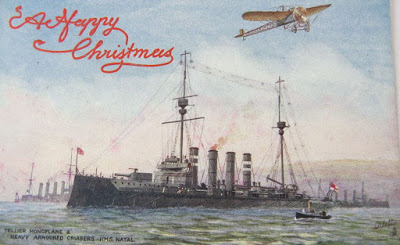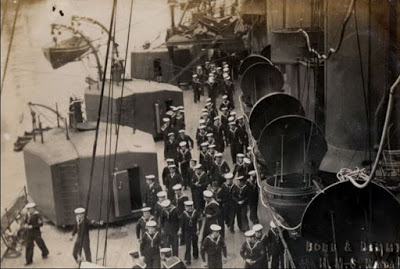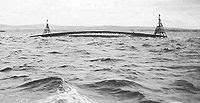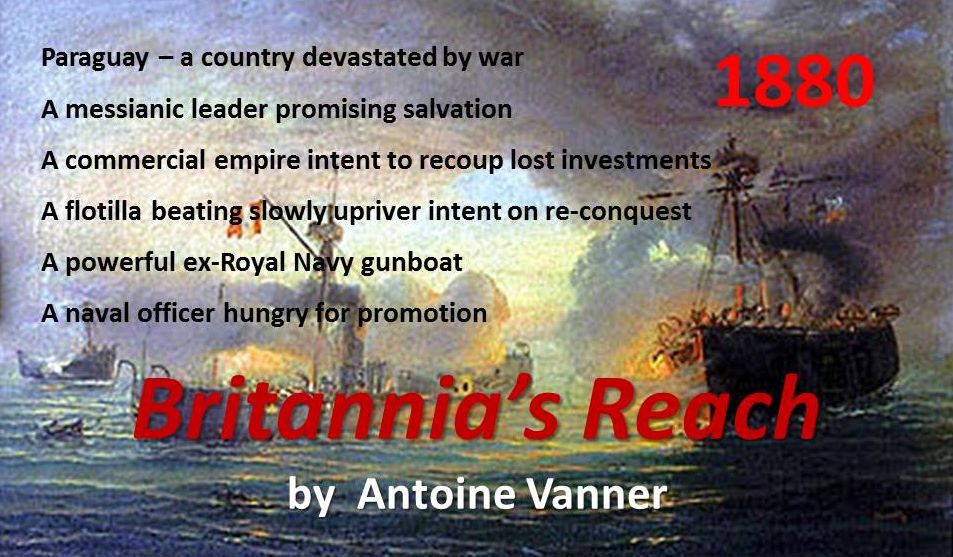The HMS Natal and SS Persia tragedies
Christmas to New Year at Sea – 1915
It was remarkable how little attention waspaid in the media, in popular memory or in large-scale centenary-commemorations in 2014-18 to the events of World War 1 at sea, other than the Battle of Jutland. And yet, throughout the war, a brutal attrition of human life occurred at sea, where the mine and the submarine were proving themselves more deadly than anticipated. Magazine explosions also took their toll. Terrible examples of tragedies were occasioned both by accident and by enemy action in what should have been a season of goodwill, the Christmas to New Year period of 1915. These included the sinking of the Royal Navy’s armoured cruiser, HMS Natal, and the liner SS Persia. There were many other vessels sunk also, involving horrific losses that are today largely forgotten except by descendants of the victims.

SS Persia – a victim oblivious of her approaching fate
At least 27 merchant and naval ships were lost to torpedoes and mines during the eight days of December 24th to 31st. A small but vicious naval conflict, the Battle of Durazzo, matched British, French and Italian naval forces against units of the Austro-Hungarian fleet off Albania with losses on both sides. Nor was enemy action alone a danger – in this era, when large numbers of sailing craft were still in use, bad weather represented a major threat. Approximately a dozen of such craft were wrecked in this short time and some brief summaries of their fates could have used wording identical to that for similar losses at any time in the previous two centuries. One such example was the three-masted Danish schooner Dana, “ driven ashore at Craster, Northumberland, United Kingdom, and wrecked.”
The most spectacular losses involved two British units, one naval, one civilian, which were lost within hours of each other on December 30th. Together, these two tragedies accounted for some 760 deaths.

HMS Natal seen – ironically – on a Christmas card (perhaps pre-war, judging by the aircraft)
HMS Natal was among the last British armoured cruisers to be built before the type was superseded by the new (and equally ill-starred) battlecruiser concept. Launched in 1905, she was one of a four-ship Warrior class, three of which were to be lost in World War 1. These vessels were as large as many contemporary battleships, displacing 13,550-tons and 505-feet long. With 23,000-hp installed power they were capable of a top speed of 23 knots. Their armament was heavy for the type – six 9.2-inch and four 7.5-inch guns, plus many smaller weapons, as well as three 18-inch torpedo tubes. Their major advantage over almost all previous armoured cruisers was that all ten main weapons were carried in turrets rather than in casemates, allowing operation in rough sea conditions. Given the size of these ships, it is not surprising that each carried a crew of up to 790.

Individual gun-turrets on HMS Natal’s starboard flank
During 1915 HMS Natal was attached to the Royal Navy’s “Grand Fleet”, which was based at Scapa Flow, the vast semi-protected anchorage in the Orkney Islands, north-east of the Scottish mainland. The patrols she undertook in the North Sea were uneventful and, like the other vessels of the Grand Fleet, HMS Natal would have spent much of her time at her moorings, waiting for news of the German fleet venturing out from its own bases. In December 1915 however she moved south to the base in the Cromarty Firth, on the Scottish east coast, and at Christmas approximately a quarter of her crew were allowed ashore on leave. On December 30th, as a gesture of goodwill, HMS Natal’s captain, Erik Black, invited civilians aboard for a film-show – then still a novelty. These invitees included family members of the crew as well as personnel from a hospital ship moored nearby, HMHS Drina. In the event – and luckily – many of them could not attend and only eight civilians came on board, seven of them women and three of them children. The party had no sooner started than a succession of explosions commenced which were to rip the vessel apart within minutes.

HMS Natal’s wreckage remained visible for many years
Boats rushed to the scene from nearby ships and some 170 survivors were dragged from the freezing water. Deaths, including the captain’s, were announced officially soon afterwards as 390, though the number has been estimated as being as high as 421, the increase perhaps due to later deaths occasioned by exposure. The immediate fear was that the anchorage had been penetrated by a German U-boat which had either fired a torpedo or dropped a mine, but evidence soon indicated spontaneous combustion of unstable cordite propellant charges stored in the after magazines. Such instability caused losses in several of the navies of the period, and the Royal Navy was to lose the pre-dreadnought HMS Bulwark to this in 1914 (750 dead) as well as the modern dreadnought HMS Vanguard in 1917 (804 dead).

SS Persia, as seen on a peace-time postcard

“The Spirit of Ecstasy”
While HMS Natal’s tragedy was unfolding another, almost as dreadful, was taking place in the Eastern Mediterranean. SS Persia was an 8000-ton passenger liner which had been built in 1900. Still in civilian service in 1915, on December 30th she was en-route to India and carrying not only passengers but a large amount of gold and jewels belonging to the Jagatjit Singh, maharajah of the princely state of Kapurthala, in the Punjab, who had left the ship at Marseilles. At midday, just south of Crete, the Persia was struck by a torpedo fired by the German submarine U-38, which has sunk another ship, the freighter Clan Macfarlane, some hours earlier at a cost of 52 lives. U-38 was commanded by Kapitänleutnant Max Valentiner (1883 –1949), who was to prove himself one of the most outstanding – and ruthless – U-boat commanders of the war. The SS Persia sank in less than ten minutes, taking 343 of the 519 people on board with her. Among the survivors was the British motoring pioneer Lord Montagu of Beaulieu, though his secretary, Eleanor Thornton, drowned. This lady was allegedly the model for the “Spirit of Ecstasy” mascot that is still featured above the radiators of Rolls-Royce cars.

SS Persia’s sinking – contemporary view
The SS Persia’s sinking caused outrage since it was without warning and violated the so-called “Arabic Pledge” that Germany had given in August 1915 and which instructed U-boat commanders not to torpedo passenger ships without notice and without allowing passengers and crew to enter “a place of safety” – i.e. the ship’s boats. Kapitänleutnant Valentiner of the U-38 was to be accused of a total of fifteen generally similar incidents involving civilian shipping (out of a total of 34 ships sunk) and after the war the Allies demanded his extradition as a war-criminal. He got around this by temporarily changing his name and hiding, though he later followed a business career in his own name. He was to serve again in the Second World War, in support of the U-boat campaign, though not going to sea. He died in 1949.
There is a sad addendum to the loss of HMS Natal. HMHS Drina, the hospital ship moored close to her, was reconverted to freighter service in 1916. The following year, as she returned from a voyage to South America with vital supplies, she was sunk off the south-west coast of Wales by a U-boat. Fifteen lives were lost.
Naval fiction in the Age of Fighting Steam
Since its original publication, the Dawlish Chronicles novel Britannia’s Reach has consistently scored 5-star Amazon reviews
For details:
For US – click here
For UK – click here
For Australia and New Zealand – click here
And, as always, Kindle Unlimited subscribers can read it at no extra cost.
The Dawlish Chronicles – now up to ten volumes, and counting. Click on the banner above for more details
Six free short stories are available for download to your Kindle. Access them by registering for the Dawlish Chronicles mailing list – just click on the banner below. You’ll be kept updated on new books and will receive other free stories at intervals.



